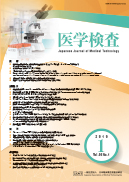Volume 72, Issue 1
Displaying 1-20 of 20 articles from this issue
- |<
- <
- 1
- >
- >|
Original Articles
-
Article type: Original Article
2023Volume 72Issue 1 Pages 1-10
Published: January 25, 2023
Released on J-STAGE: January 25, 2023
Download PDF (1145K) Full view HTML -
Article type: Original Article
2023Volume 72Issue 1 Pages 11-18
Published: January 25, 2023
Released on J-STAGE: January 25, 2023
Download PDF (860K) Full view HTML -
Article type: Original Article
2023Volume 72Issue 1 Pages 19-24
Published: January 25, 2023
Released on J-STAGE: January 25, 2023
Download PDF (611K) Full view HTML -
Article type: Original Article
2023Volume 72Issue 1 Pages 25-32
Published: January 25, 2023
Released on J-STAGE: January 25, 2023
Download PDF (713K) Full view HTML -
Article type: Original Article
2023Volume 72Issue 1 Pages 33-42
Published: January 25, 2023
Released on J-STAGE: January 25, 2023
Download PDF (10049K) Full view HTML -
Article type: Original Article
2023Volume 72Issue 1 Pages 43-54
Published: January 25, 2023
Released on J-STAGE: January 25, 2023
Download PDF (12002K) Full view HTML -
Article type: Original Article
2023Volume 72Issue 1 Pages 55-60
Published: January 25, 2023
Released on J-STAGE: January 25, 2023
Download PDF (1269K) Full view HTML
Technical Articles
-
Article type: Technical Article
2023Volume 72Issue 1 Pages 61-67
Published: January 25, 2023
Released on J-STAGE: January 25, 2023
Download PDF (3006K) Full view HTML -
Article type: Technical Article
2023Volume 72Issue 1 Pages 68-76
Published: January 25, 2023
Released on J-STAGE: January 25, 2023
Download PDF (978K) Full view HTML -
Article type: Technical Article
2023Volume 72Issue 1 Pages 77-82
Published: January 25, 2023
Released on J-STAGE: January 25, 2023
Download PDF (620K) Full view HTML -
Article type: Technical Article
2023Volume 72Issue 1 Pages 83-89
Published: January 25, 2023
Released on J-STAGE: January 25, 2023
Download PDF (12760K) Full view HTML -
Article type: Technical Article
2023Volume 72Issue 1 Pages 90-96
Published: January 25, 2023
Released on J-STAGE: January 25, 2023
Download PDF (20270K) Full view HTML -
Article type: Technical Article
2023Volume 72Issue 1 Pages 97-104
Published: January 25, 2023
Released on J-STAGE: January 25, 2023
Download PDF (918K) Full view HTML -
Article type: Technical Article
2023Volume 72Issue 1 Pages 105-114
Published: January 25, 2023
Released on J-STAGE: January 25, 2023
Download PDF (840K) Full view HTML
Materials
-
Article type: Material
2023Volume 72Issue 1 Pages 115-122
Published: January 25, 2023
Released on J-STAGE: January 25, 2023
Download PDF (6145K) Full view HTML -
Article type: Material
2023Volume 72Issue 1 Pages 123-127
Published: January 25, 2023
Released on J-STAGE: January 25, 2023
Download PDF (1223K) Full view HTML -
Article type: Material
2023Volume 72Issue 1 Pages 128-134
Published: January 25, 2023
Released on J-STAGE: January 25, 2023
Download PDF (610K) Full view HTML
Case Reports
-
Article type: Case Report
2023Volume 72Issue 1 Pages 135-140
Published: January 25, 2023
Released on J-STAGE: January 25, 2023
Download PDF (516K) Full view HTML -
Article type: Case Report
2023Volume 72Issue 1 Pages 141-147
Published: January 25, 2023
Released on J-STAGE: January 25, 2023
Download PDF (17005K) Full view HTML -
Article type: Case Report
2023Volume 72Issue 1 Pages 148-154
Published: January 25, 2023
Released on J-STAGE: January 25, 2023
Download PDF (8685K) Full view HTML
- |<
- <
- 1
- >
- >|
